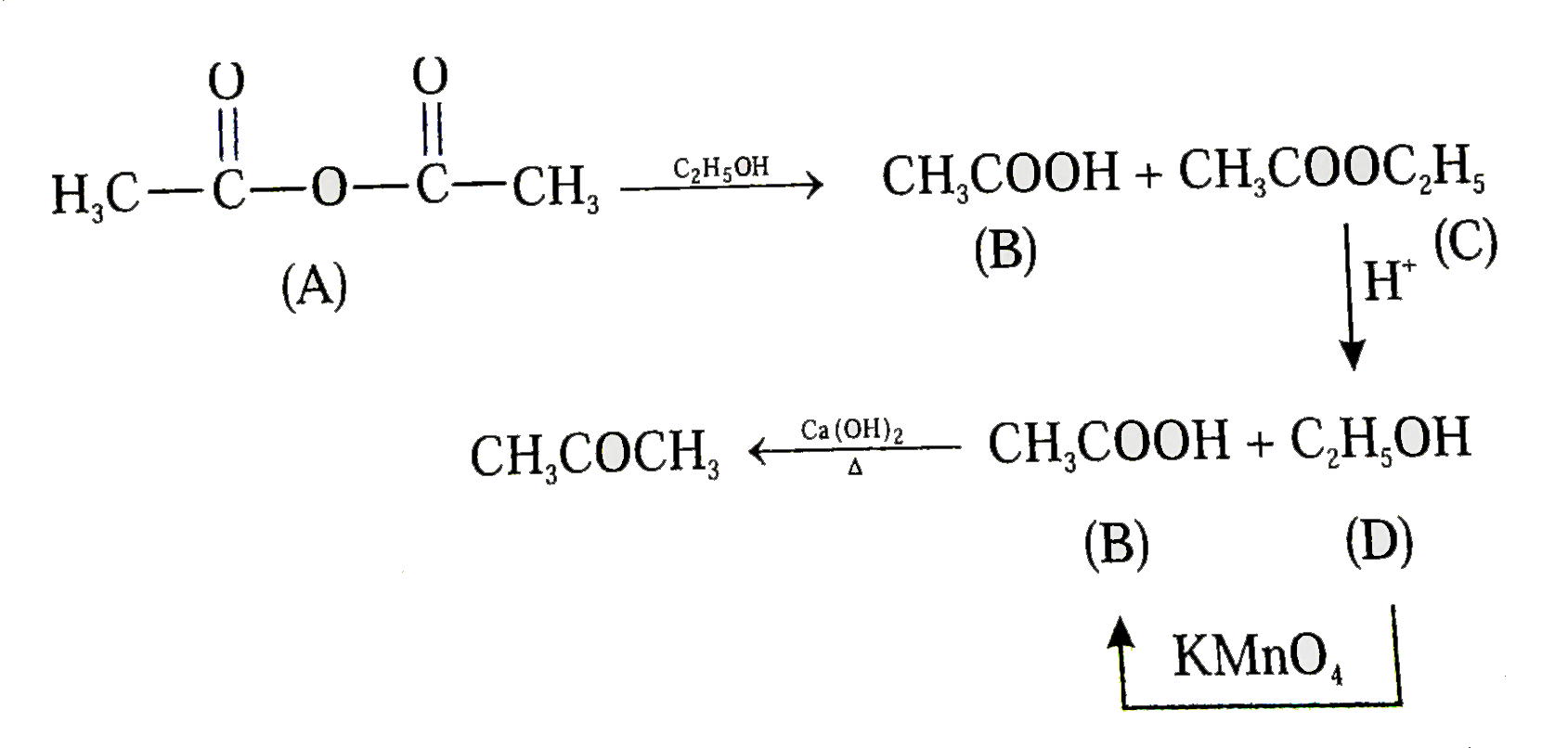An organic compound (A) on treatment with ethyl alcohol gives a carboxylic acid (B) and compound (C). The hydrolysis of (C) under acidic conditions gives (B) and (D). Oxidation of (D) with KMnO4 also gives (B). (B) on heating with Ca(OH)2 gives (E) (molecular formula, C3H6O). (E) does not give Tollens test and does not reduce Fehling's solution but forms a 2,4−dinitrophenyl hydrazone. Identify (A),(B),(C),(D), and (E).
The compound 'E' must be a ketonic compound as it does not give tollen's test and does not reduce Fehiling's solution but forms a 2,4-dinitrophenyl hydrazone. Therefore, its structure would be
(i) (E) =(E)= E=H3C−O∣∣C−CH3
(ii) Since E is obtained by heating (B) with Ca(OH)2 the compound (B) must be CH3COOH. so the given compound (A) must be CH3COOCOCH3,so the given reaction are

Topper's Solved these Questions
Similar Questions
An organic compound (A) on treatment with ethyl alcohol gives a carboxylic acid (B) and compound (C). The hydrolysis of (C) under acidic conditions gives (B) and (D). Oxidation of (D) with KMnO4 also gives (B). (B) on heating with Ca(OH)2 gives (E) (molecular formula, C3H6O). (E) does not give Tollens test and does not reduce Fehling's solution but forms a 2,4−dinitrophenyl hydrazone. Identify (A),(B),(C),(D), and (E).
View SolutionAn organic compound ‘A’ on treatment with ethyl alcohol gives a carboxylic acid ‘B’ and compound ‘C’. Hydrolysis of ‘C’ under acidic conditions gives ‘B’ and ‘D'. Oxidation of ‘D’ with KMnO4 also gives ‘B’. ‘B’ on heating with Ca(OH)2 gives ‘E’ (molecular formula, C3H6O). ‘E’ does not give Tollent’s test and does not reduce Fehling’s solution but forms a 2,4- dinitrophenylhydrazone. The compound ’E' is:
View Solution
Knowledge Check
An organic compound of formula, C3H6O forms phenyl hydrazone, but gives negative Tollen's test . The compound is
ACH2=CHOCH3BCH3CH2CHOCCH3COCH3DCH2=CHCH2OHAn organic compound of molecular formula, C3H6O , forms 2,4 - dinitrophenylhydrazone, but gives negative Tollen's test . The compound is
ACH2=CH−CH2−OHBCH3CH2CHOCCH3COCH3DCH2=CH−OCH3
An organic compound 'A' on treatment with ethyl alcohol gives a carboxylic acid 'B' and compound 'C'. Hydrolysis of 'C' under acidic conditions gives 'B' and 'D' . Oxidation of 'D ' with KMnO4 also gives 'B' . 'B' on heating with Ca(OH)2 gives 'E' (C_(3)H_(6)O). E does not give Tollen 's test and does not reduce Fehling 's solution but form a 2,4- dinitrophenyl hydrazone . How many carbon are present in product (E ).
View SolutionAn organic compound (A) reacts with ethanol to give (B) and (C). On acid hydrolysis (C ) yields (B) and (D). oxidation of (D) gives (B). (B) is an acid and forms a salt with Ca(OH)2 which on dry distillation gives (E ), C3H6O. Give the structures of (A) to (E ) with proper reasoning.
View SolutionAn organic compound (A) (molecular formula C8H16O2) was hydrolysed with dilute sulphuric acid to give a carboxylic acid (B) and an alcohol (C ). Oxidation of (C ) with chromic acid produced (B). (C ) on dehydration gives but-1-ene. Write equations for the reactions involved.
View SolutionAn organic compound (A) (molecular formula C8H16O2) was hydrolysed with dilute sulphuric acid to give a carboxylic acid (B) and an alcohol (C ). Oxidation of (C ) with chromic acid produced (B). (C ) on dehydration gives but - 1 - ene. Write equations for the reactions involved.
View SolutionCompound (A) of molecular formula C9H7O2Cl exists in ketoform and predominantly in enolic form (B). On oxidation with KMnO4, (A) gives m-chlorobenzoic acid. Identify (A) and (B).
View SolutionAn organic compound (A) (C6H10) on reaction with CH3MgBr followed by acid treatment gives compound (B). The compound (B) on ozonolysis gives compound (C ), which in the presence of a base gives 1-acetylcyclo-pentene (D). The compound (B) on reaction with HBr gives (E ). Write the structures of (A), (B), (C ), and (E). Show how (D) is formed form (C ).
View Solution
